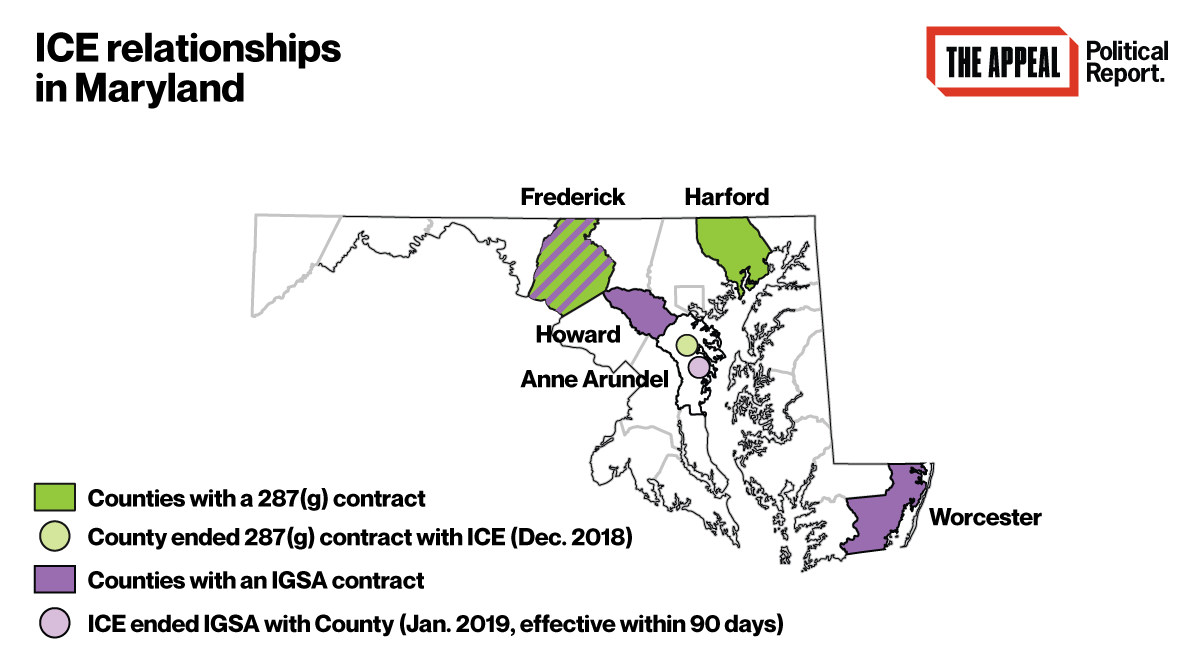Political Report
Two ICE Partnerships Come to an End in Maryland’s Anne Arundel County, Unexpectedly
“We don’t believe local government and local communities should be making money by causing harm to other community members,” said one advocate.

“We don’t believe local government and local communities should be making money by causing harm to other community members,” said one advocate.
ICE announced on Wednesday that it would terminate its detention contract with Anne Arundel County within 90 days. This unexpected move means that ICE will no longer hold people in the county’s Ordnance Road Correctional Center. And it comes in the heels of a proposal by County Executive Steuart Pittman to provide legal defense funds for the people ICE detains there.
Pittman, a Democrat, won in November after campaigning against two new ICE partnerships struck by his GOP predecessor.
He quit the first partnership—a 287(g) contract—in December, as promised. The 287(g) program authorizes local law enforcement to research the immigration status of people they arrest. “The program does … utilize valuable detention staff during a time where staffing shortages are well documented,” his office wrote in a Dec. 27 report. “The stigma of the program also impacts police outreach efforts—particularly in hispanic/latino communities.” (Anne Arundel is the third county that has left 287(g) as a result of the 2018 elections, alongside two in North Carolina.)
But in December Pittman also decided to maintain the second partnership with ICE: an IGSA, or Intergovernmental Service Agreement. This is a contract by which a county rents out jail space to ICE. The county detains people that ICE has arrested (often in other jurisdictions) in exchange for a nightly fee. This arrangement can be lucrative for a county’s budget. According to the county, ICE paid Anne Arundel more than $4 million over the IGSA’s first 13 months.
In the December report, Pittman’s office justified his reversal by stating that detention conditions at the Ordnance Road Correctional Center, where the ICE detainees are kept, are “more humane” than those of the other facilities where detainees would be relocated.
At the time, Pittman also announced that he would propose using some of the revenue received from ICE to provide legal assistance to the ICE detainees held in the county.
“I don’t believe that these people should be detained at all,” Pittman told me in a phone interview on Thursday. “But because the president of the United States wants to remove these people, he is going to house them somewhere, and we had a facility that was unoccupied and the ability to do it in a humane way.”
Gabriela Kahrl, an attorney with the immigration clinic of the University of Maryland, told me one day before ICE’s termination announcement that she supported Pittman’s decision to keep the IGSA contract because it would provide “legal counsel to people who are being detained anyway.” While Kahrl opposes the practice of immigration detentions altogether, her argument was that ICE will still be holding these individuals even it has to move them out of Ordnance Road, so why would the county not agree to detain them if it is willing to give more legal assistance and support than others would? Besides Pittman’s proposed defense fund, she touted the fact that Anne Arundel has a larger immigrant community and more immigration attorneys than comparatively isolated jails where detainees may be relocated. Groups like Bronx Defenders and the Brooklyn Defender Services have made similar arguments as part of the debates on New Jersey’s IGSAs.
But on Wednesday ICE decided on its own to end the IGSA. Kahrl believes that the agency did this because it feared that people brought to Ordnance Road would soon be able to mount stronger defenses. “I think this is them wanting to do their work without having to concern themselves with the due process of those they’re detaining,” she told me right after ICE’s announcement. “I don’t know that for a fact, but it certainly seems to be their reaction to providing meaningful legal representation. … They figured they can’t get away with running roughshod over the process, that this is going to interfere with their ability to expedite the deportation of people who have a legal claim to stay in the United States.”
ICE’s Baltimore field office, which is responsible for Maryland, did not respond to a request for comment on what motivated the decision. Pittman told me on Thursday that ICE had not answered his own requests for an explanation either. “Some have speculated that they didn’t want to do business with Anne Arundel County because they don’t like the direction that we have gone politically, and some have even speculated that my commitment to providing legal assistance for the detainees was something that offended them,” he said. Pittman added that detainees having legal representation was in ICE’s interest: “It’s more efficient, they have a backlog of cases, and it’s proven over and over again that when people have an attorney they go through the process quickly… If that’s their reason for no longer wanting to do business here, they’re working against their own interest as well as against the interests of the detainees.”
Even some critics of Pittman’s decision to keep the IGSA questioned ICE’s reasons for ending it. Nick Steiner, an attorney with the ACLU of Maryland, told me on Monday that he found Pittman insufficiently supportive of immigrants. “There’s this backward kind of thinking, ‘I want to help immigrants but I am still going to participate in their jailing,'” he said. Maintaining the IGSA was only defensible, Steiner added, if Pittman directed “100 percent of the money he gets for caging those immigrants to providing health and universal representation… If he’s going to participate in that deportation machine, then he needs to be way more committed.” But the Capital Gazette reported that the county was only proposing to set aside 10 percent or less for legal representation, with the rest going to “detention staffing [and] public safety.”
Steiner said after ICE’s announcement that Pittman’s proposal just made ICE look worse. “I still stand by the idea that what [Pittman] was willing to commit, or what he had said he would commit, wasn’t enough,” Steiner told me. “But it just shows that ICE is so opposed to immigrant detainees having representation that even a small portion of the money going to immigrant representation is not something they could swallow… They can’t stand even the possibility of immigrants having due process or protections of any kind.”
Regardless of what drove Wednesday’s decision, Elizabeth Alex, the senior director of community organizing at the immigration advocacy organization CASA, was celebrating the end of ICE detentions in Anne Arundel County. She called the development “awesome” and “amazing.”
“We don’t believe local government and local communities should be making money by causing harm to other community members,” she said.
Alex does not believe that the IGSA’s end would worsen conditions for immigrants. She rejects the premise that the same number of ICE targets will be detained whether or not Anne Arundel has a detention contract. “There are thousands and thousands of people that are in the middle of an immigration process, and most of them are not detained at a given time,” she said. “ICE will detain based on a variety of factors and … a critical factor in those decisions is the availability of beds in detention centers. If there are more beds there will be more people in the beds.”
What can Anne Arundel County now do to help individuals who are held by ICE or face deportation?
Advocates called on Pittman to still set aside funds to help immigrants. “There doesn’t have to be a immigrant detention center in Anne Arundel County for a universal defense fund to happen,” Steiner said. Anne Arundel could emulate other Maryland counties like Prince George’s that provide legal representation to their poor residents even if ICE has transferred them to another jurisdiction. Kahrl said this policy should be extended to cover not just residents but also people employed within a county. In other words, instead of providing representation to immigrants it directly detains, Anne Arundel County could choose to provide representation to people who lived or worked there but who are now detained elsewhere.
“I’m going to sit down with [local] organizations and talk about how to best serve that population,” Pittman said. “All options are on the table, but we have no plans at the moment to implement a legal defense fund.”
Three other Maryland counties (Frederick, Howard, and Worcester) currently have IGSAs, and none provide legal funds to ICE detainees. Frederick and Howard, like Anne Arundel, are governed by a Democratic county executive and council.

